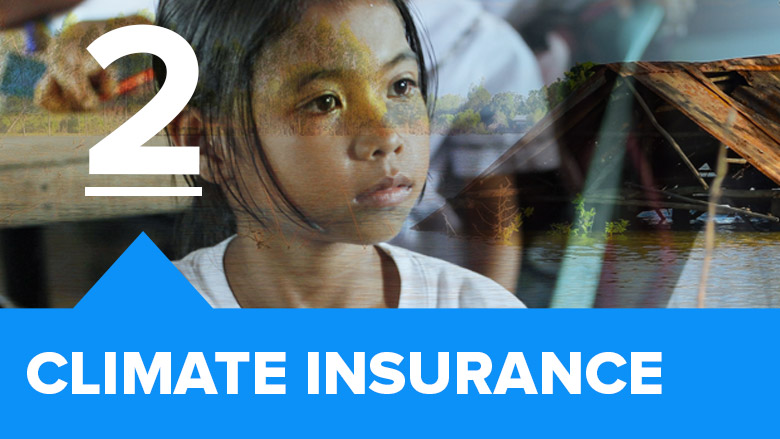Challenge and opportunity
In an emergency, seconds count. For a relief effort, rapid access to funds can also make the difference by enabling early action. For people who live close to the edge this can be a lifeline. In September 2017, just two weeks after two major hurricanes swept through the Caribbean, 10 Caribbean countries received over $55 million in insurance payouts through the Caribbean Catastrophe Risk Insurance Facility (CCRIF) to help with emergency response and begin the recovery process.
Insurance solutions can help bolster early action in the face of a disaster, and speed up recovery to restore livelihoods and rebuild critical infrastructure so that people, communities and economies can rebound. The World Bank, the Global Facility for Disaster Reduction and Recovery, together with partners, are developing insurance solutions and providing finance to help vulnerable countries proactively manage disaster risks through a portfolio of financial instruments.
In 2015, for example, thanks to the insurance policy it purchased through the Pacific Catastrophe Risk Assessment and Financing Initiative (PCRAFI), another World Bank-supported risk finance instrument, Vanuatu received $2 million to support recovery just seven days after cyclone Pam devastated the country. While it may not seem like much, the payout was eight times larger than the government’s emergency budget. It was critical in the effort to fly nurses to the most-affected areas to provide life-saving assistance.
Beyond sovereign solutions (insurance schemes where the government itself is the policyholder), individuals and households can also access insurance coverage against the impacts of disasters. The World Bank Group’s Global Index Insurance Facility (GIIF), for example, provides catastrophic risk transfer solutions and index-based insurance to smallholder farmers, micro-entrepreneurs, and microfinance institutions in developing countries. It has facilitated $151 million in insurance covering about 6 million people, primarily in Sub-Saharan Africa, Asia, and Latin America and the Caribbean.
IFC is also active in this space and has a successful collaboration with Indonesia’s PT Reasuransi MAIPARK to develop insurance solutions for the country’s agribusinesses against the increasing threat and costs of natural disaster and climate events.
Insurance solutions can help governments protect national budgets as well as the lives and livelihoods of their citizens from the impacts of disasters, ultimately safeguarding economic development and poverty reduction efforts. Every year, an estimated 26 million people are pushed into poverty by disasters such as droughts, floods, cyclones, and earthquakes. When accounting for impacts on well-being, disasters cost the global economy an estimated $520 billion a year, with vulnerable countries, and particularly their poorest communities, experiencing the brunt of disaster impacts.
Accelerating this global effort, Germany, the United Kingdom, the World Bank and GFDRR and over 30 NGO and private sector partners have launched a new Global Partnership - called InsuResilience, co-chaired by the V20 and G20. The Partnership’s goal is to scale up climate risk finance and insurance solutions in developing countries. It will stimulate the creation of effective climate risk insurance markets and the smart use of insurance-related schemes for people and risk-prone assets in developing countries.
Transformative Action:
The Philippines is among the world’s most vulnerable countries to natural disasters. In August 2017, the Philippines established the first-of-its-kind subnational catastrophic risk insurance program that provides 25 provinces with more than $100 million in insurance coverage against major typhoons by pooling risk and transferring it to private reinsurance markets. This marks the first time the World Bank has entered into a reinsurance agreement with a governmental agency, and the first time it is executing a catastrophe risk transaction in local currency.
Under this program, the government-owned insurance agency, Government Service Insurance System, will provide catastrophe risk insurance to both the national government and the 25 participating provinces. The World Bank serves as an intermediary to transfer the agency’s risk to a panel of international reinsurers which were selected through a competitive bidding process–Nephila, Swiss Re, Munich Re via the subsidiary NewRe, Axa, and Hannover Re. Air Worldwide provides the underlying risk modeling for the transaction.
This is the first-ever subnational risk-pooling mechanism. The program is part of the government’s continued efforts to strengthen national and local capacity to manage and respond to disasters. It builds on six years of intensive partnership with the World Bank, including the preparation of the first catastrophe risk model for the country and the adoption of a Disaster Risk Finance Strategy by the Philippines Department of Finance.
Expected Results
Over the years, the government of the Philippines has invested in a portfolio of financial instruments that provide comprehensive protection against the impacts of disasters and climate shocks, including a contingent line of credit with the World Bank.
The country is expected to incur, on average, $3.5 billion in asset losses each year due to typhoons. This new insurance program will support the country in responding to impacts of severe natural disasters. By providing 25 provinces with access to rapid financing, they can take early action in the immediate aftermath of a disaster, ultimately reducing humanitarian and development impacts.
Key facts & figures
- Every year, an estimated 26 million people are pushed into poverty by natural disasters.
- Every year, disasters cause an average of $300 billion in economic losses. But these numbers don’t tell the full story. When accounting for impacts on well-being, disasters actually cost the global economy 60% more than usually reported, or $520 billion/year.
- Quick-disbursing financial protection instruments, such as contingent credit and insurance, can reduce humanitarian impacts and save money by enabling rapid crisis response and relief efforts. In Ethiopia, for example, every $1 secured ahead of time for early drought response can save up to $5 in future costs.
- Over the past 10 years, 26 countries in three regions—Africa, the Pacific, and the Caribbean and Central America—have joined sovereign catastrophe risk pools.
